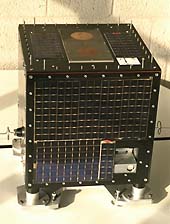
Magnetococcus strain MC-11
Magnetorquing describes a family of techniques for spacecraft attitude control that relies on interactions between spacecraft-generated magnetic fields and external magnetic fields -- usually just one external field, the Earth's, and usually only for small satellites in LEO.
Biomagnetorquing would use magnetic fields generated by living organisms -- specifically, magnetotactic bacteria but possibly also magnetotactic algae2 which have a much higher magnetic moment.3 Inside these magnetotactic microorganisms, magnetosomes -- cuboidal building blocks of magnetized metal -- naturally form; these blocks self-assemble into larger magnets, nanometric strands of ferric material that are still too small to resolve with an optical microscope.
For exovivaria, whose rotation for artificial gravity would already provide spin-stabilization, the only likely long-term attitude control requirement would be to keep the axis sun-pointing as the Earth travels around the sun. Attitude control would also be important for establishing sun-pointing in the first place. Magnetorquers have been proposed for small satellites in equatorial orbits to maintain sun-pointing.4
For attitude control applications such as these, which would require little power, there could be several advantages of biomagnetorquing over conventional attitude control. Specifically, one can list:

Tubsat-A used magnetorquers
- Orbital debris mitigation. If a biosatellite disintegrates (whether slowly or catastrophically), the magnetic components of the magnetorquers will be far too small to pose a threat to other spacecraft.
- Durability. There would be no permanent moving parts to wear out or go awry, which cannot be said of some other propellantless attitude control mechanisms like reaction wheels.
- Recyclability. If a "starter" culture can be maintained,5 biomagnetorquers might be grown only as sun-pointing needs arose. Sun-pointing might require adjustments only every few months. Electromagnets that would ordinarily be used on exovivaria only for small robotic actuators might be used to orient the magnetotaxic microorganisms in a non-metallic matrix (some exovivarium-produced biodegradable material, or possibly ice) to make as many bio-magnets as needed for the attitude change. These biomagnets could then be recycled.

Earth as a "geodynamo" magnet
Biomagnetorquing faces a number of design challenges, among them:
- strength - can strong enough magnets be grown?
- mechanics - how do you determine the optimal deployment of magnets?
- economics - could the investment required to culture magnetotaxic species and deploy them for attitude control be better spent elsewhere on exovivaria?
Biomagnetorquing is currently under consideration by Project Persephone for a partial-proof-of-concept experiment on KickSat.6
1 "Magnetococcus sp. MC-1", DOE Joint Genome Institute. This strain is the only one with a pure culture available. ⇑
2 See e.g.,Magnetite and Magnetotaxis in Bacteria and Algae, R.B. Frankel, Francis Bitter National Magnet Laboratory, MIT, 1986^. Genetically engineered algae using genes from bacteria are another possibility, see e.g., LANL develops first genetically engineered "magnetic" algae, September 27, 2011 ⇑
3 See e.g., ^F.F. Torres de Araujo, M.A. Pires, R.B. Frankel, C.E. M. Bicudo, "Magnetite and Magnetotaxis in Algae", Biophys. J. 50(2) Aug '86, pp. 375-378 doi:10.1016/S0006-3495(86)83471-3 ⇑
4 See e.g., Sedlund, C.A. "A simple sun-pointing magnetic controller for satellites in equatorial orbits". IEEE 2009 Aerospace Conference. DOI 10.1109/AERO.2009.4839544 ⇑
5 The environmental requirements of magnetotaxic microorganisms are unlikely to be optimal for exovivaria ecosystems. ⇑
6 "KickSat -- Your personal spacecraft in space!", Zachary Manchester, Cornell University Space Design Studio ⇑
Further reading
- Christopher T. Lef�vre, Fernanda Abreu, Ulysses Lins and Dennis A. Bazylinski, "A Bacterial Backbone: Magnetosomes in Magnetotactic Bacteria" (doi 10.1007/978-3-642-18312-6_4) in Metal Nanoparticles in Microbiology, Mahendra Rai, Nelson Duran (eds), Springer (April 12, 2011) ISBN 3642183115